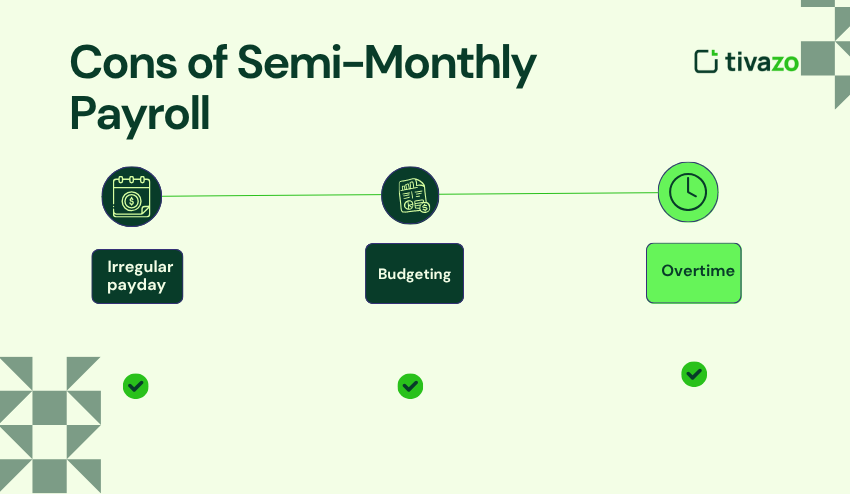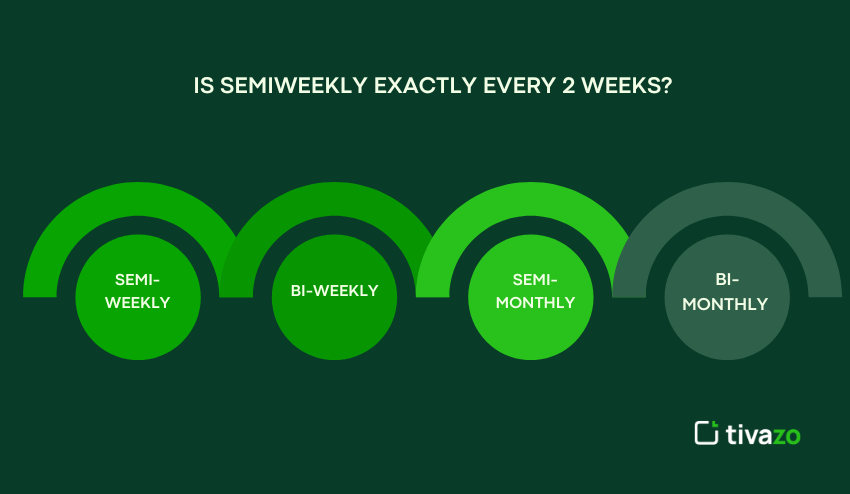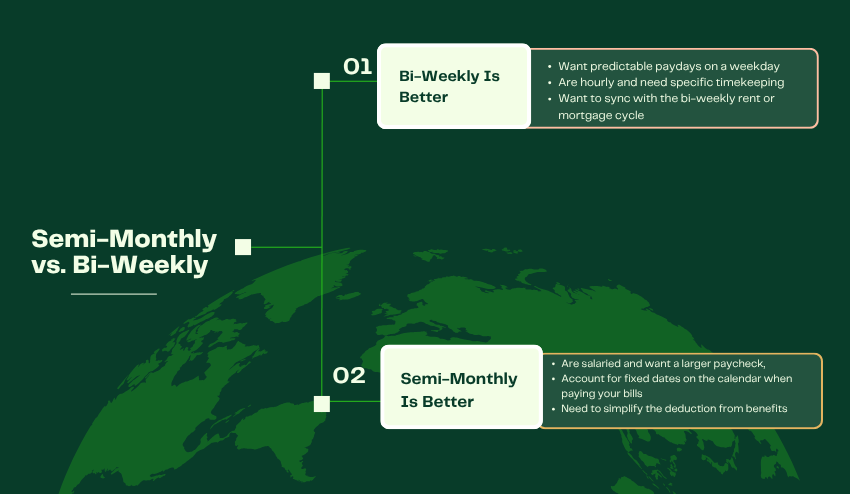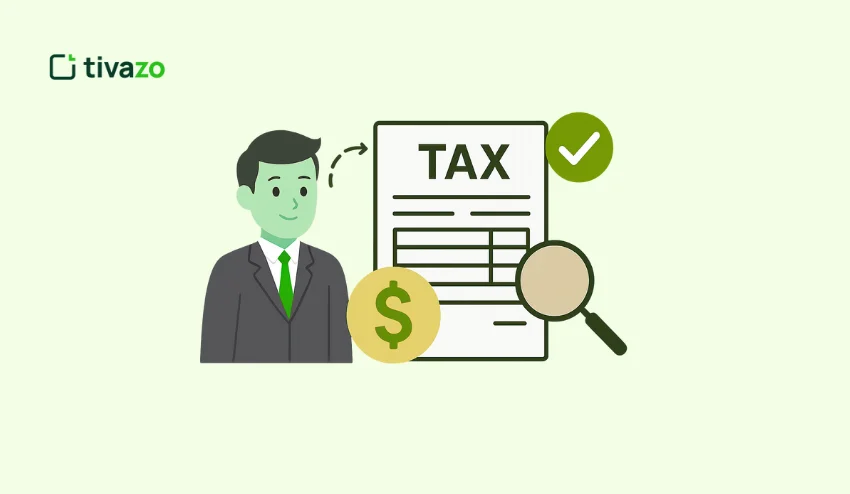Understanding how you are compensated is important for your finances, whether you are the employee or the employer. Semi-monthly vs bi-weekly pay is often a common one that many employees and employers alike get confused over. Are they the same thing? Which is better? What are the differences between the two? What are the pros and cons of each?
This long-form blog post will compare semi-monthly vs bi-weekly pay and discuss how Tivazo can better serve teams, employers, and employees in understanding and managing the payroll cycles semi-monthly and bi-weekly.
Many professionals do not think about how payroll frequency can impact their financial health and situation. For example, for hourly employees who are paid bi-weekly, budgeting can become easier, because typically the payroll date is on a Friday. Conversely, salaried deadlines allow employees to pay bills based on their set monthly expenses, which is an attractive feature of a semi-monthly paycheck. What happens on a team that has salaried and hourly employees, and they are all in different countries, states, or time zones?
That’s where Tivazo fits in. Tivazo is a modern workforce management solution that gives organizations the want to process payroll easily using either semi-monthly vs bi-weekly payroll. Tivazo supports hybrid payroll models and integrates with time and attendance, so you get the best of both worlds.
Key Highlights:
- Semi-Monthly vs. Bi-Weekly – What Is the Difference?
- Is Semi-Monthly the Same as Bi-Weekly?
- Why is it so important to understand semi-monthly vs bi-weekly?
- Cons of Semi-Monthly Payroll
- Which Is Correct? Bi-Monthly or Semi-Monthly?
- Is Semiweekly Exactly Every 2 Weeks?
What is Semi-Monthly?
Semi-monthly means twice a month. For example, employees get paid on fixed dates like the 15th and last day of the month, resulting in 24 pay periods per year.
Semi-Monthly vs. Bi-Weekly – What Is the Difference?
Although semi-monthly vs. bi-weekly can seem vastly alike, they are very different in structure.
| ATTRIBUTE | SEMI-MONTHLY | BI-WEEKLY |
| Frequency | 24 times/year (twice per month) | 26 times/year (every 2 weeks) |
| Pay Dates | Set dates (e.g. 15th & 30th) | Every 2 Weeks (e.g. every other Friday) |
| Paycheck Amount | Slightly larger per check | Slightly smaller per check |
| Months with 3 Paychecks | None | Two months each year |
The difference between semi-monthly vs bi-weekly affects not only employees’ budgeting, but also payroll processing, human resource management, and financial planning. Many global teams even compare payroll tools like Tivazo with other deel alternatives to determine which platform best supports different pay cycles across regions.
Is Semi-Monthly the Same as Bi-Weekly?
No, semi-monthly is not the same as bi-weekly!
Even with their close frequencies, semi-monthly vs bi-weekly schedules differ in the number of pay periods per year. Semi-monthly employees get paid on regular, set dates, such as the 1st and 15th or the 15th and 30th. Bi-weekly employees get paid every two weeks, on a common day of the week, like Friday. In total, semi-monthly pay will give employees a total of 24 paychecks in a year, and bi-weekly pay will give employees 26.
While the additional two pay periods bi-weekly can feel like a bonus during surge months with three paychecks, it often means semi-monthly payments are larger per paycheck because the annual salary is divided by 24 instead of 26. Overall, this influences everything from cash flow planning, benefit deductions, tax withholdings, and even retirement contributions.
Having to administer these systems manually can create issues or mismatches for HR or payroll professionals. This is why it is important to have tools like Tivazo. The payroll configuration module in Tivazo allows organizations to offer semi-monthly vs bi-weekly payroll options at the same time, and flexibility for organizations with diverse teams:
It auto-corrects timesheets with overtime, ensuring paychecks are on time, whatever pay schedule it issues. Whether paying regular staff or virtual networks, understanding the differences between semi-monthly vs bi-weekly creates payroll precision, transparency, and satisfied employees.
Why is it so important to understand semi-monthly vs bi-weekly?
Whether you are an employer, tracking employee time, or budgeting, knowing the difference between semi-monthly and bi-weekly is important. Here’s why:
- Employees pay monthly bills and contribute to savings that require planning.
- Employers need to maintain payroll distinctly different from reports for accounting purposes.
- HR departments using Tivazo or similar tools benefit from consistency and automation.
The decision about how people are paid can influence employee engagement, accuracy in payroll calculations, and even retaining talent in a growing organization. Employers are just as likely to blow payroll timing as staff are to create chaos with their pay. This mistake may be compounded in organizations with global, hybrid, or simply busy workforces. Correspondingly, one of the reasons Tivazo allows you to flexibly manage payroll with both pay cycles is to avoid confusion, by enabling transparent and trusted pay practices between employer and employee.
Cons of Semi-Monthly Payroll
Although semi-monthly pay is commonplace in salaried positions, it does come with disadvantages:
1. Irregular payday
You might not get paid on the same day of the week as each payday will fall on different days of the week (e.g., Monday one month, Friday the next month), which can also add realize semi-monthly vs bi-weekly may matter if you’re looking for consistency.
2. Budgeting
Using semi-monthly instead of bi-weekly can be difficult when budgeting because not all months have the same number of working days.
3. Overtime (for hourly employees)
It might be more challenging for you to calculate your overtime pay using semi-monthly pay. With Tivazo’s timesheet integration, we eliminate the concern because your hours are tracked for each pay cycle, precisely when you work.

Which Is Correct? Bi-Monthly or Semi-Monthly?
Let’s clarify this confusing point: semi-monthly is two times a month, while bi-monthly usually means one time every two months.
This distinction is important for payroll discussions. The terms semi-monthly and bi-monthly are often used interchangeably, leading to confusion around pay expectations. While semi-monthly vs bi-weekly are easily highlighted, it is important to note that bi-monthly doesn’t even bear comparison in most payroll systems. Bi-monthly would rarely be used in the corporate world when paying employees, as this equates to only 6 paychecks per yearhardly a workable scenario for anyone managing monthly bills, payday loans, or rent.
Semi-monthly guarantees 24 evenly spaced payments per year; semi-monthly (24 pay frequencies per year) is one of the most common pay cycles found for salaried individuals. Employers and their teams, especially for diverse or remote employees, need to think of using consistent terminology to avoid confusion around payroll processing and expectations.
Tivazo will allow HR teams to avoid these mixed terminology issues simply by establishing predefined payroll labels in all onboarding documents, payslips, and dashboards. No matter if you are offering semi-monthly vs bi-weekly pay, Tivazo makes the expectations very clear to your employees about what to expect and when; it also has a built-in glossary to assist you as well.
Is biweekly pay the same as twice a month?
No. When paid biweekly, you are paid every two weeks, for a total of 26 paychecks per year. When paid twice a month, you are paid semi-monthly, for 24 paychecks in a year.
An easy way to visualize the semi-monthly vs bi-weekly pay periods is in the table below:
| Month | Semi-Monthly Payroll dates | Bi-weekly Payroll dates |
| January | 15th and 30th | 5th, 19th |
| February | 15th and 28th | 2nd, 16th |
| March | 15th and 30th | 1st, 15th, and 29th |
This slight difference of two paychecks on semi-monthly vs bi-weekly in a year can certainly affect yearly budgets, timing of tax reporting, and scheduling of deductions for benefits. This is a difference you do not need to worry about, thanks to Tivazo and our robust payroll module that allows you to tailor your payroll as you see fit.
Is Semiweekly Exactly Every 2 Weeks?
No! Semiweekly is twice per week, not every two weeks!
This is often confused with bi-weekly, which does mean every two weeks. If you are updating information during payroll, you want to be aware of the terminology:
- Semi-weekly – Every 3-4 days
- Bi-weekly – Every 14 days
- Semi-monthly – Twice per month
- Bi-monthly – Once every two months
A semiweekly pay period means an employee would receive two paychecks each week, which signifies it would be important to ensure you don’t interchange semiweekly with bi-weekly, because that could cause long delays in the payroll process. In larger organizations with global teams or independent contractors, it could be disastrous. For that reason, Tivazo creates breakdowns of the terminology as well as customizable labels for pay frequency so that HR and Finance can stay accurate, consistent, and compliant, while setting up a semi-monthly vs bi-weekly payroll, whether it is for scenarios, planned, or recurring.

What is the difference between biweekly and semi-monthly mortgage payments?
Believe it or not, the debate over semi-monthly vs bi-weekly also applies to mortgages.
| Factor | Bi-weekly mortgage | Semi-Monthly mortgage |
| Payments per year | 26 | 24 |
| Amount of principal paid off | Faster | Slower |
| Total interest paid | Less | More |
Biweekly payments essentially allow you to make one extra mortgage payment a year. This will enable you to pay less interest and shorten the length of your loan. So, no matter whether you are paying employees or your home loan, understanding semi-monthly vs. bi-weekly really pays off.
Semi-Monthly vs. Bi-Weekly. Forget which is better?
Depends on your goals.
Bi-Weekly Is Better For You If You:
- Want predictable paydays on a weekday
- Are hourly and need specific timekeeping, like overtime
- Care about how many more paychecks you have in 2 of the months per year
- Want to sync with the bi-weekly rent or mortgage cycle
Semi-Monthly Is Better For You If You:
- Are salaried and want a larger paycheck,
- Need to account for fixed dates on the calendar when paying your bills,
- Need to simplify the deduction from benefits.
- Are in finance, HR, or an industry that spends financially/budgets monthly.
With Tivazo’s payroll software, you can design tailored semi-monthly vs bi-weekly cycles for your organization. One thing our clients enjoy about Tivazo is the ability to have various features.

Real Life Example Using Tivazo
Imagine that you have a startup company that has remote working teams in the Philippines and the U.S. Your development team prefers to pay every two weeks because of their weekly sprint cycles and to embrace their agile work style. Your design team is working on milestone projects and likes a semi-monthly pay schedule, because it gives them more predictability to manage their rent or loan repayments and personal budgets.
Managing two payroll cycles, in different time zones, with no central platform, can only create problems with mistakes, delays, compliance, and many other issues.
But with Tivazo, you can:
- Set custom payroll frequencies for departments (bi-weekly for dev, semi-monthly for design)
- Sunset your tracking of timesheets and pay summary so all employees get accurate work logs and payment for public information
- Significantly reduce overtime and benefits to tiered semi-monthly vs bi-weekly staff paid out without rework
- Produce payslips that are tax compliant for both countries based on statutory requirements
Tivazo will allow you to record attendance (time in, time out, break time, and holidays), all of which feed into the correct payroll schedule. Also, your smart dashboard enables HR leaders to view payroll insights by providing instant access to payroll trends, budget projections, employee costs, and more.
By removing the friction of balancing semi-monthly vs bi-weekly payrolls, Tivazo can save you hours!
How Tivazo Simplifies Payroll Management
Here’s how Tivazo makes everything easier:
| Feature | Benefit |
| Dual Pay Cycle Support | Easily manage semi-monthly vs bi-weekly pay cycle |
| Integrated Time Tracking | Accurate hour and overtime tracking |
| Smart Budget Planning | Pay cycles aligned with business objectives |
| HR & Payroll Automation | More accuracy and transparency |
| Performance + Pay Dashboard | Link hours worked to pay |
At Tivazo, our goal is to be transparent and eliminate the pain of work, no matter if you are freelancing, working remotely, or growing a team.
Conclusion
There’s no clear-cut answer when it comes to semi-monthly vs bi-weekly pay periods. The main consideration is just how each pay cycle affects payroll, budgeting, and employee happiness.
Whether you are a human resource professional, business owner, or remote worker, Tivazo allows you to stay ahead of your pay cycles with real-time pay cycle visibility, automation, and flexible options.
From having a global workforce to connecting time to pay periods, Tivazo is accommodating even the most complex payroll situations so your business runs smoothly.
You will also have configurable notifications, automate compliance notice updates, and create audit-ready reports are all available in one design-friendly dashboard.
So, when you ask yourself, semi-monthly vs bi-weekly, you can rest assured, Tivazo is already solving those problems, and you can instead focus on building your team, not fixing payroll issues.




